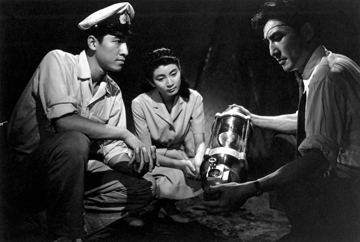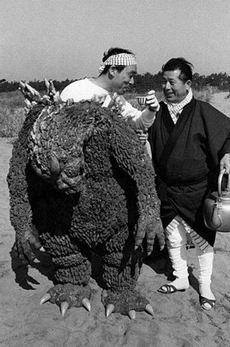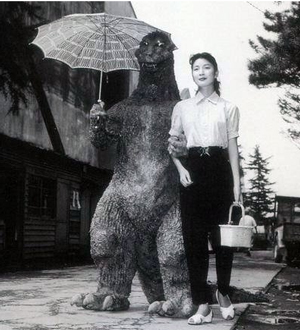
 |
|
|
|
Criterion's new Blu-ray release regards Ishirô Honda's Godzilla as a major landmark of postwar atomic anxiety. Ten years ago the original Japanese Gojira drew a flurry of journalistic interest on its belated American theatrical release in America. Audiences were impressed by its overt references to Hiroshima and the utter destruction of Tokyo. A fine DVD from 2006 double-billed Gojira with its highly successful American version, Godzilla, King of the Monsters. Criterion's Blu-ray gives us new HD transfers of both versions, along with commentaries and interview extras that address questions that have bothered film fans for fifty years. Why would the only country ever to suffer nuclear attacks produce such a masochistic fantasy about their national trauma? 
This original Japanese-language Gojira balances its spectacular monster rampage against human issues and post-atomic moral questions. Japanese sailors are irradiated and their ship sunk by an unknown flash of light and heat that continues to destroy other vessels. Searching for the cause, scientist Dr. Yamane (Takashi Shimura) travels to a tiny fishing island, and is confronted by a colossal water dragon. It soon comes ashore to march through Tokyo, leaving a broad wake of utter destruction. Conventional weapons prove useless, which puts the mysterious, secretive Dr. Serizawa (Akihiko Hirata) in a bind: he's invented a new device he calls an "Oxygen Destroyer" but refuses to use it against the monster. He feels morally compromised: if the device's existence is revealed, governments will rush to exploit it as another weapon of mass destruction. Serizawa's fiancée Emiko Yamane (Momoko Kôchi) begs the scientist to reconsider. The scenes of Godzilla crushing Tokyo underfoot thrilled American youngsters of the 1950s. Toho would later expand and tame the franchise, adding new monsters and adapting the formula to create a series of increasingly juvenile epics. But every schoolchild of the late '50s knew that Godzilla was a symbolic substitute for The Bomb, and was curious why the Japanese would make such a movie. According to the esteemed Japanese critic Tadao Sato, the vision of Tokyo once again reduced to ashes allowed Japanese audiences to deal with the communal guilt still felt over the war. Producer Tomoyuki Tanaka did not copy the theme of Ray Harryhausen's The Beast from 20,000 Fathoms, a popular movie about a dinosaur revived by a bomb test. Godzilla is not a dinosaur but a new force of nature, a dragon that breathes Atomic fire. 
Godzilla was made soon after the end of the American Army's occupation of Japan. Rather than address the wartime nuclear bombings, events still spoken of in hushed tones, producer Tanaka seized upon the topical Lucky Dragon 5 incident, in which a Japanese tuna boat defied warnings to stay clear of the Bikini Atoll, unaware that the U.S. was testing its new Hydrogen bomb. As critic David Kalat points out in his Criterion commentary, Gojira restages the event, substituting the radioactive monster for the nuclear blast. The horror-beast rising from the Pacific to threaten Tokyo is an enormous political statement: for much of the world, America will forever be seen as an Atomic aggressor. Seen in this rejuvenated presentation, Eiji Tsuburaya's special effects look better than ever. Considering the limited technical means available in 1954, the resourceful Toho technicians found clever ways to combine their rubber Man-in-suit-a-saur with live action and impressive miniatures. Hand-rotoscoped mattes are employed to composite the beast into several shots. Stop-motion animation sees use in a couple of shots as well. What's most impressive is the depth of focus maintained on the miniatures, even with the camera rolling at four-times speed. The "towering titan of terror" is unlike the giant monsters in American movies. Godzilla is not a dinosaur or giant animal, but a cultural fantasy. He rises from the sea not to eat or spawn, but for the express purpose of annihilating Tokyo. Godzilla is a post-modern version of a traditional Yokai demon, writ large. And that billowing, notably non-reptilian hide? He's meant to look like a walking atomic mushroom cloud! Godzilla involves us in its human drama, even if the characters are orchestrated along familiar lines. The scientist has a beautiful daughter (Momoko Kochi, with her endearing, Gene Tierney-like overbite) who must choose between an eager young salvage operator and her fiancé, a morbidly-obsessed scientist who does bad things to goldfish in his Rotwang-like mad lab. All that is missing from the American formula is a representative of the military. Ishirô Honda's sober and respectful direction makes its anti-nuke statement without resorting to moralizing speeches. The specter of the bombings is always present, despite the absence of an overt author's message referencing the bombing. 
The Criterion Collection's Blu-ray of Godzilla is an improvement on all earlier video versions. The blizzards of dust specks that marred earlier releases have been all but eliminated. Many scenes still carry fine scratches, but all the major damage has been repaired. Criterion disc producer Curtis Tsui is responsible for some of the label's best fantasy discs, including Georges Franju's Eyes without a Face. His extras for Godzilla are on the same level as those for any other great work of world cinema. First up is the 1956 American re-cut, Godzilla, King of the Monsters, the version most commonly shown in other international markets. Director Terry Morse skillfully shoehorned additional scenes with Raymond Burr into the narrative. Burr's fly-on-the-wall reporter narrates the movie, aided by a newly imposed flashback structure. Rather than a pastiche, the American version is well written and cleverly assembled. This transfer is from pre-print film materials and looks far better than earlier videos. It includes the original Trans-World logo and closing credit crawl, albeit from a 16mm source. Author David Kalat provides an impassioned pair of commentaries for both feature versions. He explains what the original Godzilla represented to Japanese audiences, and examines the strange cultural re-mix of the American version. Critic Tadao Sato explains some of the political context of the time in Japan, and offers his personal analysis of Japan's monster-who-became-a-friend. Other interviews give us input from the beloved composer Akira Ifukube, actors Akira Takarada and Haruo Nakajima, the man who played Godzilla inside the rubber suit. Two effects technicians also comment, but an effects-oriented featurette has only a few examples to offer. Much better is a piece about the terrible fate of the sailors of the Lucky Dragon 5. With last year's near nuclear meltdown at Fukushima, Godzilla's anti-nuke stance is more relevant than ever. 
Trailers for both movies are included. The soundtrack for the King of the Monsters trailer throws an uninterrupted tirade of hyperbole at the audience, that must have left schoolboys in 1956 with their mouths hanging open:
Criterion's packaging sports colorful, imaginative cover art, which has instant possibilities as a commercial poster. As a special surprise, the folding disc holder opens up like a pop-up book to display a fiery image of "Big G" in all his glory. I imagine that some of the more fanatical Godzilla fans will be incensed that the monster image is not the original Godzilla, but a leaner, meaner design from the 1990s. Critic Sato opines that the fast-moving American Godzilla from 1998 had little appeal, and after seeing the Criterion extras we understand why. The 1998 monster is just a big lizard coming home to roost in New York City, like Ray Harryhausen's The Beast from 20,000 Fathoms. Toho's original Gojira is a symbolic demon from the ghost-subconscious, the Stuff that Atomic Dreams are Made Of.
On a scale of Excellent, Good, Fair, and Poor,
Godzilla Blu-ray rates:
Reviews on the Savant main site have additional credits information and are often updated and annotated with reader input and graphics. Also, don't forget the 2011 Savant Wish List. T'was Ever Thus.
Review Staff | About DVD Talk | Newsletter Subscribe | Join DVD Talk Forum |
| ||||||||||||||||||